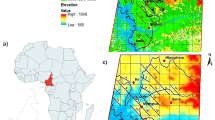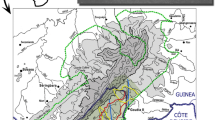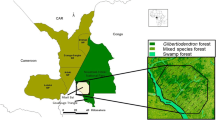Abstract
The population of chimpanzees in the Kalinzu Forest, Uganda was censused with nest counts using the line-transect method. Four methods were examined to estimate density. The estimated densities, ranging from 2.0 to 4.7 chimpanzees per km2, all indicated a high population density, in comparison with other chimpanzee habitats. Moreover, the density in the logged area of the Kalinzu Forest was higher than that in the unlogged area. Several factors are thought to contribute to the high density in the Kalinzu Forest. Notable are the mosaic forest structure dominated by mature forest with patches of logged areas, selective logging of non-food tree species of chimpanzees, and low hunting pressure. These results suggest that selective logging may be a practical means of primate conservation in places where timbers are exploited.
Similar content being viewed by others
References
Anderson, J. R. &E. A. Williamson, 1983. Chimpanzees of Sapo Forest, Liberia: density, nests, tools and meat-eating.Primates, 24: 594–601.
Boesch, C. &H. Boesch, 1983. Optimization of nut-cracking with natural hammers by wild chimpanzees.Behaviour, 83: 265–286.
Butynski, T. M., 1985. Primates and their conservation in the Impenetrable (Bwindi) Forest, Uganda.Prim. Conserv., 6: 68–72.
Carroll, R. W., 1986. Status of the lowland gorilla and other wildlife in the Dzanga-Sangha region of south western Central African Republic.Prim. Conserv., 7: 38–41.
Gates, C. E., W. H. Marchall, &D. P. Olson, 1968. Line transect method of estimating grouse population densities.Biometrics, 24: 135–145.
Ghiglieri, M. P., 1984a.The Chimpanzees of Kibale Forest. Columbia Univ. Press, New York.
————, 1984b. Feeding ecology and sociality of chimpanzees in Kibale Forest, Uganda. In:Adaptations for Foraging in Nonhuman Primates,P. S. Rodman &G. H. Cant (eds.), Columbia Univ. Press, New York, pp. 161–194.
Hoppe-Dominik, B., 1991. Distribution and status of chimpanzees (Pan troglodytes verus) on the Ivory Coast.Prim. Rep., 31: 45–75.
Howard, P. C., 1991.Nature Conservation in Uganda’s Tropical Forest Reserves. IUCN, Gland & Cambridge.
Ihobe, H., 1993. A preliminary study on distribution of chimpanzees in region de Niari and Lekoumou, Congo.Prim. Res., 9: 119–125. (in Japanese with English abstract)
Johns, A. D. &J. P. Skorupa, 1987. Responses of rain-forest primates to habitat disturbance: review.Int. J. Primatol., 8: 157–191.
Kano, T., 1972. Distribution and adaptation of the chimpanzee on the eastern shore of Lake Tanganyika.Kyoto Univ. Afr. St., 7: 37–129.
————, 1984. Distribution of pygmy chimpanzees in the Central Zaire Basin.Folia Primatol., 43: 36–52.
---- &R. Asato, in press. Hunting pressure on chimpanzees and gorillas in the Motaba River area, northern Congo.Afr. St. Monogr., 15.
Nishida, T. &S. Uehara, 1983. Natural diet of chimpanzees (Pan troglodytes schweinfurthii): long-term record from the Mahale Mountains, Tanzania.Afr. St. Monogr., 3: 109–130.
Plumptre, A. J. & V. Reynolds, in press a. The effect of selective logging on the primate populations in the Budongo Forest Reserve, Uganda.J. Appl. Ecol., 1994, 31.
---- & ----, in press b. Censusing chimpanzees in the Budongo Forest: a comparison of techniques.Int. J. Primatology.
Reynolds, V. &F. Reynolds, 1965. Chimpanzees of the Budongo Forest. In:Primate Behavior: Field Studies of Monkeys and Apes,I. DeVore (ed.), Holt, Rinehart & Winston, New York, pp. 368–424.
Skorupa, J. P., 1986. Responses of rainforest primates to selective logging in Kibale Forest, Uganda: a summary report. In:Primates: The Road to Self-sustaining Populations,K. Benirschke (ed.), Springer Verlag, New York, pp. 57–70.
————, 1987. Do line-transect surveys systematically underestimate primate densities in logged forest?Amer. J. Primatol., 13: 1–9.
Struhsaker, T. T., 1975.The Red Colobus Monkey. Univ. of Chicago Press, Chicago.
Sugiyama, Y. &J. Koman, 1987. A preliminary list of chimpanzees’ alimentation at Bossou, Guinea.Primates, 28: 133–147.
———— & ————, 1992. The flora of Bossou: its utilization by chimpanzees and humans.Afr. St. Monogr., 13: 127–169.
Suzuki, A., 1969. An ecological study of chimpanzees in a savanna woodland.Primates, 10: 103–148.
————, 1977. The society of chimpanzees and their adaptation. In:The Chimpanzees,J. Itani (ed.), Kodan-sha, Tokyo, pp. 251–336. (in Japanese)
Tutin, C. E. G. &M. Fernandez, 1984. Nationwide census of gorilla (Gorilla g. gorilla) and chimpanzee (Pan t. troglodytes) populations in Gabon.Amer. J. Primatol., 6: 313–336.
Wrangham, R. W., 1975. Behavioural ecology of chimpanzees in Gombe National Park, Tanzania. Ph.D. thesis, Univ. of Cambridge, Cambridge.
Author information
Authors and Affiliations
About this article
Cite this article
Hashimoto, C. Population census of the chimpanzees in the Kalinzu Forest, Uganda: Comparison between methods with nest counts. Primates 36, 477–488 (1995). https://doi.org/10.1007/BF02382870
Received:
Accepted:
Issue Date:
DOI: https://doi.org/10.1007/BF02382870




